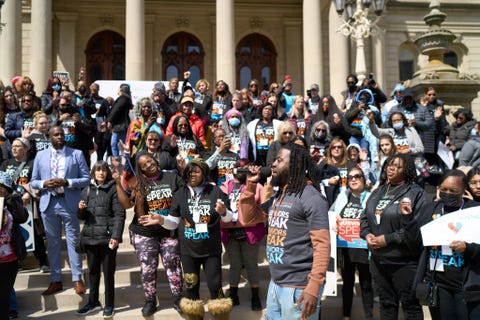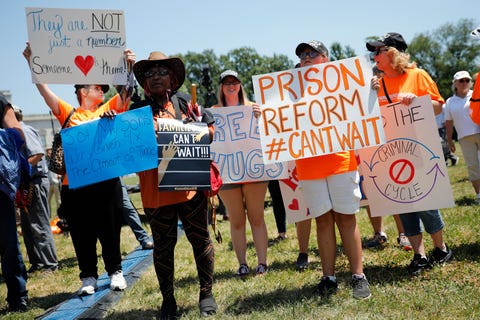If you’re one of the millions of Americans who plans to vote in a hotly contested political race this November, chances are you’ve spent the last few months being bombarded with attack ads about crime. Huge postcards clog your mailbox. Menacing videos stream on social media and loop on your TV, featuring grainy black-and-white footage of graphic violence and stern voiceovers accusing various candidates of being “soft on crime.”
This year, campaigns are spending big to convince us that crime is out of control. The Wall Street Journal recently reported that in a competitive U.S. House district in North Carolina, roughly 70 percent of all political ads on TV since Labor Day have “at least touched on crime.” Crime has also been “prominently mentioned” in more than one-third of congressional campaign TV ads since Labor Day in Pennsylvania and Wisconsin, two states with competitive Senate races this year. A lot of these ads blame crime on candidates who have supported criminal justice changes like police reform, bail reform, or clemency. They tout tough law and order messages that hark back to the 1980s, when political jockeying about violent crime led our country down the path to mass incarceration.
But are these ads really informing us which candidates will work to keep us safer—or are they propagating a harmful story about the state of criminal justice in America?
Are we really less safe today?
Separating scare tactics from legitimate concerns can feel impossible among a frenzy of conflicting messages. But it’s essential to set aside politics and look at the facts, especially for women voters who are perennial targets for these ads, including the so-called “security mom” voting bloc—typically suburban, white women from upper- and middle-income households who swing between candidates during times of perceived crisis, ultimately voting for the candidate that promises a return to safety.
The reality is there has been a devastating increase in homicides starting when COVID hit, especially gun-related homicides. From 2019 to 2020, homicides increased by nearly 30 percent, one of the largest single-year increases ever recorded. But not all crime is going up, and accurate data is limited for 2021.
What is clear is that the burden of violent crime is unevenly shared. The people most likely to be victims of crime are low-income folks, communities of color, young people, people with disabilities, LGBTQ+ people, unhoused people, and people with old criminal records. The crimes they suffer are less likely to be successfully investigated, and they are less likely to receive victim assistance. The most harmed are the least helped by our current justice system.
What hasn’t worked so far
A decade ago, I left my job as a prosecutor to advocate for justice reform alongside leaders organizing with those most harmed and least helped. Together, we have won remarkable reforms, and I have learned many hard truths, most importantly that our current justice system is just not set up to actually prevent crime or protect victims. The old solutions to crime don’t work.
For one, most victims do not trust the justice system, which leads to scant reporting. National data found less than half of all violent victimizations were reported to law enforcement in 2021. That includes only about 20 percent of sexual assaults and less than 50 percent of assaults or domestic violence incidents. In 2022, my organization, Alliance for Safety and Justice, commissioned Crime Survivors Speak, a national study that found victims often do not report because they have no faith the justice system will be able to do anything, and because they fear retaliation. That lack of faith is warranted: the same study found that four out of five victims who reported a crime to the police never saw the crime against them solved.
Victims also do not receive help when they need it most. Our 2022 survey found 96 percent of violent crime victims did not receive compensation, and despite nearly half of violent crime victims wanting financial or economic assistance to recover, only 16 percent received it.
Not supporting victims has dire consequences. Ray Winans, CEO of Detroit Friends and Family, a violence prevention organization, told me about one young man, Eric, who was a bystander when he was shot and paralyzed. He was unable to keep his job and needed housing accommodations, but he was denied victim compensation by the state compensation program. He became so desperate to survive that he sold his own pain medication, something he had never done before. Then he was convicted of selling drugs, making access to jobs and housing even harder. Ray hypothesized that Eric was a victim of one public health crisis—gun violence—which contributed to another—drug addiction—all because he didn’t receive help as a victim.
At the same time, lengthy sentences championed by politicians from both parties have failed. In 2014, the National Academy of Sciences released a comprehensive study of mass incarceration and concluded that, in addition to creating extreme racial disparities, “lengthy sentences are ineffective as a crime control measure.”
From the 1980s to present day, mass incarceration has devastated families and communities, while larger and larger shares of state budgets went to policing and prisons, college tuition soared, and mental health and youth programs were slashed.
So, what can be done?
Looking closely at the outcomes of crime policy is sobering—but there is reason for hope. The solutions are right in front of us, often led by the very people the justice system has failed most. From community-based violence prevention for at-risk youth to mental health crisis assistance, and reentry programs for people coming home from prison to trauma recovery centers that help victims of violence—new solutions are cropping up all over the country.
Take Newark, New Jersey, which has long been listed as one of the “most dangerous” cities in the U.S. In 2014, newly elected Mayor Ras Baraka set out to address the rampant violence and deep distrust between the justice system and the community. Mayor Baraka enlisted violence prevention expert Aqeela Sherrills and launched the Newark Community Street Team. The city and the community worked together to build one of the most comprehensive public safety strategies in the country. It includes community-led peacemaking outreach, before- and after-school programs, hospital-based violence disruption, and a trauma recovery center.
The impact has been tremendous. Newark’s homicide rate in 2019 was its lowest since 1961. While gun violence spiked in many cities after COVID, Newark’s rate remained flat.
We can’t go back to politics as usual
This midterm election, we must take the problem of rising gun violence seriously. But we can’t fall for the same political tactics that contributed to the problem.
Throughout the 1980s and 1990s, fear of crime drove mass incarceration, and criminal justice lobbyists partnered with victims’ rights advocates to push “law and order” policies, becoming one of the most successful political movements in the 20th century.
Now, new safety leaders from communities that are most harmed by concentrated violence and failed tough justice policies are challenging this paradigm and reimagining our response. In turn, we must hold public safety policy to a higher standard and invest in community solutions that prevent crime, help victims, and promote healing.
We can’t cling to the politics of fear, even if it’s appealing. Many of us are exhausted, navigating a crushing economy and grieving lost loved ones and lost time. Sound bites that promise easy fixes might feel safe. But “tough on crime” never was.
We owe it to each other to educate ourselves about what didn’t work in the past and about real solutions communities are building today. When we abandon the myths, it opens up a path toward real safety—for all of us.
Lenore Anderson is the founder and president of Alliance for Safety and Justice and the author of In Their Names: The Untold Story of Victims’ Rights, Mass Incarceration, and the Future of Public Safety.



